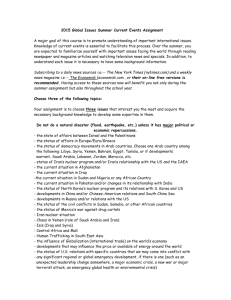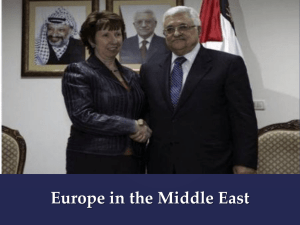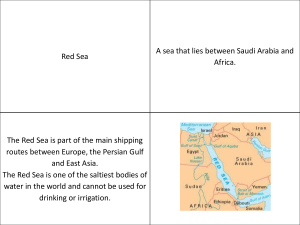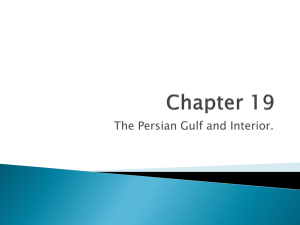Babak Arzani
advertisement
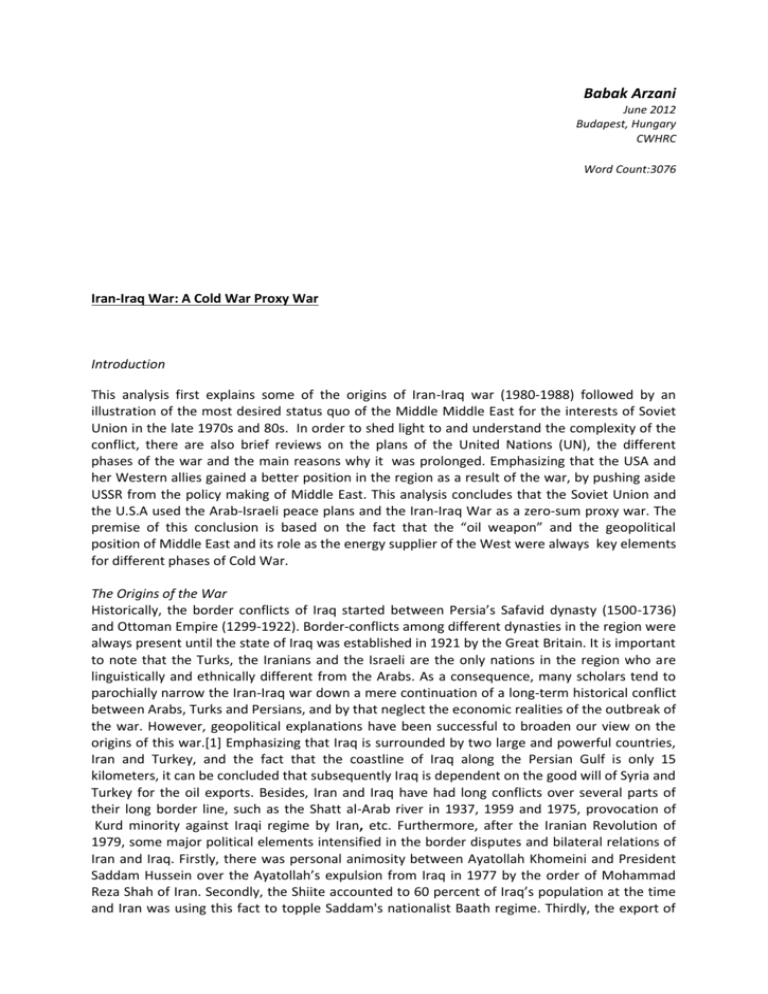
Babak Arzani June 2012 Budapest, Hungary CWHRC Word Count:3076 Iran-Iraq War: A Cold War Proxy War Introduction This analysis first explains some of the origins of Iran-Iraq war (1980-1988) followed by an illustration of the most desired status quo of the Middle Middle East for the interests of Soviet Union in the late 1970s and 80s. In order to shed light to and understand the complexity of the conflict, there are also brief reviews on the plans of the United Nations (UN), the different phases of the war and the main reasons why it was prolonged. Emphasizing that the USA and her Western allies gained a better position in the region as a result of the war, by pushing aside USSR from the policy making of Middle East. This analysis concludes that the Soviet Union and the U.S.A used the Arab-Israeli peace plans and the Iran-Iraq War as a zero-sum proxy war. The premise of this conclusion is based on the fact that the “oil weapon” and the geopolitical position of Middle East and its role as the energy supplier of the West were always key elements for different phases of Cold War. The Origins of the War Historically, the border conflicts of Iraq started between Persia’s Safavid dynasty (1500-1736) and Ottoman Empire (1299-1922). Border-conflicts among different dynasties in the region were always present until the state of Iraq was established in 1921 by the Great Britain. It is important to note that the Turks, the Iranians and the Israeli are the only nations in the region who are linguistically and ethnically different from the Arabs. As a consequence, many scholars tend to parochially narrow the Iran-Iraq war down a mere continuation of a long-term historical conflict between Arabs, Turks and Persians, and by that neglect the economic realities of the outbreak of the war. However, geopolitical explanations have been successful to broaden our view on the origins of this war.[1] Emphasizing that Iraq is surrounded by two large and powerful countries, Iran and Turkey, and the fact that the coastline of Iraq along the Persian Gulf is only 15 kilometers, it can be concluded that subsequently Iraq is dependent on the good will of Syria and Turkey for the oil exports. Besides, Iran and Iraq have had long conflicts over several parts of their long border line, such as the Shatt al-Arab river in 1937, 1959 and 1975, provocation of Kurd minority against Iraqi regime by Iran, etc. Furthermore, after the Iranian Revolution of 1979, some major political elements intensified in the border disputes and bilateral relations of Iran and Iraq. Firstly, there was personal animosity between Ayatollah Khomeini and President Saddam Hussein over the Ayatollah’s expulsion from Iraq in 1977 by the order of Mohammad Reza Shah of Iran. Secondly, the Shiite accounted to 60 percent of Iraq’s population at the time and Iran was using this fact to topple Saddam's nationalist Baath regime. Thirdly, the export of the Islamic revolution of Iran was aiming to remove the Iraqi regime to fulfill Khomeini's ambitions for a stronger sovereignty over the Sunni region. The outbreak of war happened when Saddam’s ambition for becoming the superpower of the region by expanding Iraq’s access to the coastline seemed reachable. Possibly it was the miscalculation about Iran’s weak and unstable post-revolution military that made Iran a tempting target for Saddam to change the status quo in the Persian Gulf countries. The causes of the final trigger of the attack remain unclear, but the war set on when 22nd September 1980 Iran was shelled by Iraqi forces who simultaneously captured 4000m2 of the oil-rich Khuzistan province in southern Iran. The Soviet Union’s Desired status quo in Middle East Before analyzing the actual course of the war, the main interests of the USSR and the U.S.A. in the Middle East should be briefly outlined. The main interests of the USSR and the USA in the region can be reduced to the function of oil in diplomacy on one hand, and the USSR’s borders with non-socialist countries like Iran and Afghanistan on the other hand. In a nutshell, the Middle East was a crucial oil-rich area at the heart of the rivalry between communism capitalism. The U.S.A was mainly afraid that Iran’s oil fields would become nationalized, jeopardizing the world energy marker, or the country herself would become socialist, and subsequently USA’s interests in the Persian Gulf would be perished. The Soviet Union, on the other hand, was worried of a pro-Western Iran who could be used against the Soviet Union and its Arab allies. Until 1973 and only among Arabs in the region, Soviet Union was the most favorable superpower for the Arab nations chiefly because the U.S.A. and its allies were backing Israel and Iran, the two non-Arab countries of the region. Also, most of the Arab countries had active communist or nationalist parties and political ties with Moscow, such as the Baath regime of Syria and President Gamal Nasser of Egypt. The reason why this status quo before the war was favorable for the USSR, could be best seen in the incident of 1973’s “oil weapon” by Arab countries against the West in response to the U.S. decision to re-supply the Israeli military during the Yom Kippur war (1973). Moscow benefited from this oil embargo for the following reasons: • The Soviet Union’s oil self sufficiency broadened its oil transactions and subsequently its foreign policy. • Nationalized oil fields and the right of participating in existing oil concessions for Arab countries could be used for new boycotts against Western and Japanese market. In this status quo the Soviet Union was able to negotiate closely with the West and exchange oil for political and economic favors.[3] Therefore a peaceful, united and anti-imperialist region was favorable for the Soviet Union. One should bear in mind that the term anti-imperialism was used in that region against former colonialist-imperialist Western countries such as Great Britain and France, and also USA who was seen as the continuation of the same doctrine in its newest form. This thought was emphasized in the region by USSR’s propaganda campaign and communist parties in Middle East countries. In other words, unrest inside the Arab countries, or dispute among them and especially related to their foreign policy toward Israel, could be damaging to the Soviet Union’s economic and political power-hold in the region. Israel The role of Israel cannot be excluded from any analysis on the power politics of the Middle East in the Cold War era, as the Arab-Israeli conflicts have been continuous ever since the creation of the state of Israel and the remarkable American support for the Israeli. Israel , and to an extend pre-revolutionary Iran, were disturbing elements for the U.S.A. to change this status quo. Ever since the state of Israel was established Western countries including USA aided unconditionally Israel with her disputes with the Arabs. whether or not the continuation of this help, especially by USA, were because of sharing the same values, the the sense of guilt of the World War II, colonialist ambitions of West, Jewish lobbies in USA, and etc. is not the purpose of this essay. However, the real fact concerning in this matter is that this aid was seen by Arabs, and portrayed by USSR, as the continuation of colonialism policies of West. Therefore, the mere fact that the U.S.A. always backed Israel was a great unifier for Arab countries. In spite of U.S, Moscow was helping them with military and diplomatic aids and subsequently her benefits in the region became theirs and vice versa. The continuation of the War Until 1982, the first phase of the war, The UN, Algeria and the USA were all asking for withdrawal of Iraqi forces from Iranian territory while Iraq was not willing to negotiate. USA and her allies in the West, feared that the energy supply stream of the Persian Gulf would be blocked by the war and since they had no diplomatic negotiations with Iran or Iraq, Algeria, who was in charge of solving the Iran_Iraq border issue from 1975, was assigned to bring the war to an end. Surprisingly however, Iran seemed satisfied with continuation of the war. Khomeini was facing a lot of troubles internally. There were many nationalist and socialist parties in Iran at the time and they were asking Khomeini to step out of power as he promised in the early days after revolution. Now the Iran_Iraq War was a great opportunity for Khomeini to: first, rally nationalist sentiments around the revolution and the war, and second suppress internal rivals for power.[4] After 1982, as Iran’s forces were pushing Iraqi forces beyond and over the border, there was a pause that offered an opportunity for negotiations. However, because the aircraft of Algeria’s prime minister and the entire team of experts, who had worked on the Iran_Iraq issue since 1975, was shot down by Iraqi airplane the diplomatic discourse was closed. The real motivation behind this act is still vague, especially because Iraq was loosing in the battlefield. Also, due to the opportunity for Iran’s radical Islamists’ to solve the internal crises and fractions inside revolutionary forces, and definitely their foreign policy miscalculation about winning the war, attacks were launched against Iraqi forces and the second phase of the war began. The role of the UN after the second phase was restricted to observation since the discourse was closed. Also Arab members of the UN were not willing to pursue negotiations. Mainly because these countries, especially Saudi Arabia, found the war a good excuse to let the main Persian Gulf superpowers exhaust themselves on the battlefield instead of posing their sovereignty on the Persian Gulf and the Organization of the Petroleum Exporting Countries’ (OPEC) diplomacy making. The reason why USA and her Western allies were silent in this time is explained further in this essay. How the War Damaged Moscow We should keep in mind that before the outbreak of the war, Soviet Union was already going towards a dark period in her relations with Arab states. The Islamic uprisings in Arab states were condemning Communism as much as Western Imperialism. Furthermore, the Soviet Union had to favor a group in inter-Arab conflicts and inner-state party disputes, especially between communist and nationalist parties in Syria and Iraq, and therefore alienate other groups. At the same time the wealth resulting from 1973’s “oil weapon” enabled Arab states to buy technology from the West and open a new phase with their relations with the West. To exemplify, China and France had different negotiations with Arab states, especially with Egypt, which were opposing those of the Soviet Union. Therefore, the unity of Arab states around anti-imperialism was getting broken and as a result the desired status quo for the Soviet Union was changing. However, the most damaging elements that eliminated Moscow’s peaceful balance in the Middle East had happened radically: President Sadat of Egypt left the anti-Imperialism campaign over the Camp David process in 1979. Moscow attacked Afghanistan to rescue the communist regime of this country in 1979. The communist party of Afghanistan seized power in the 1978 coup and had alienated the Afghan people to an extend that gave rise to radical islamists. And finally the outbreak of Iran-Iraq in 1980. So from the beginning of the 1980s, Moscow’s desirable balance in the Middle East had changed. The U.S.A.’s Goals in the Region As outlined earlier in this essay, USA’s main interests in the region were basically oil and the threat she could oppose to the Soviet Union by using her allies, Iran and Israel, in the region. USA and her Western allies needed the flow of oil without any hardship and blockage and for that they needed to have a dominant position in Persian Gulf. For reaching these goals the USA’s ideal picture of the Middle East would be a subservient regimes around Persian gulf without nationalized oil or prevailing socialist ideology. The attempt of actually trying to realize this ideal could for instance be seen in the 1953 Iranian coup d'état which the CIA overthrew the democratically elected Prime Minister Mohammad Mosaddegh of Iran on 19 August 1953.# However, as mentioned earlier the balance of the region was quite favorable for the Soviet Union until the Egypt–Israel Peace Treaty at Camp David in 1979. Changes in Region’s Status Quo Until 1979 Moscow had had great hopes of fixing her problems with the Arab world. However, the Camp David Peace Treaty, the invasion of Afghanistan, and the Iran-Iraq War damaged Soviet Union’s credibility and power in the regions. The Arab countries were divided into three groups over Camp David and Afghanistan. 1. Countries supporting the Camp David-process and the West, but opposing the invasion of Afghanistan (e.g. Egypt). 2. Camp David and Anti-Imperialist countries like Syria and Libya which supported Afghanistan’s invasion. 3. Centrist countries like Saudi Arabia, Iraq, United Arab Emirates, Kuwait, etc., which were against both Camp David and the Afghanistan invasion. The USA realized that these divisions could be beneficial for her interests. The goals of the USA in the region could finally be fulfilled, if the third and the first group were pushed toward each other. In other words if centrist Arabs states who were mostly around Persian Gulf would join the pro-West campaign. Contrary to this, Moscow, knowing the previous balance is out of reach, needed the centrist countries to stand next to the anti-imperialist group so that they neutralize USA’s power over pro-West states. Fortunately for the U.S.A., she could find a common cause uniting centrists and pro-West states: the continuation of the Iran-Iraq war. The threat of Iran possibly exporting the Islamic revolution around the region, enabled the USA to sign military and political treaties with Sunni Arab countries around the Gulf, who were afraid of Iran’s ambitions of expansion and the tanker war in the Persian Gulf. Also, the USA benefited by strengthening it’s military presence in the Middle East by building up a military compounds in the Persian Gulf and Indian Ocean. Consequently the Soviet Union lost her hand in the matters of the region, except for the antiimperialist states like Syria, Libya and South Yemen and in some occasions the Palestinian Liberation Organization (PLO). Moscow knew already that she cannot turn the region into its prewar status, simply because she had no influence on Iran’s new regime or Iraq’s Saddam except by pressuring over Saddam by Syria. The policy which eventually turned Saddam into the USA campaign. Also, the war was becoming politically and economically beneficial for parties, or in some countries like Iran political elites involved: Ayatollah Khomeini was persecuting his internal enemies and the realist politicians of Islamic Republic were opening military and economical relations like Iran Contra with USA ,USA and France were selling arms to Iraq and other Arab countries of the Gulf, Israel, Syria and North Korea were selling arms to Iran, USA and the West got into the political diplomacy of Arab countries, USA established military compounds in the Persian Gulf and Indian Ocean, French oil companies started to work in Egypt and Iran, etc. Therefore, it is understandable why USA and her Western allies were reluctant to pursue a peace plan. The cheap oil flow was guaranteed and negotiations with Arab states was secured as long as the war continued, USSR was loosing her influence in the region, and finally he arms manufacturers were really benefiting from the war. The relation between Israel_Arab conflict and Iran_Iraq war The main reason why neither USA nor USSR never directly intervened in the Israel_Arab conflict or the Iran_Iraq war, was the fact that any direct intervention or too much provocation would have led to a superpower conflict. Knowing fact of the arms trade and realizing Israel’s unwillingness to make peace with Palestine, Moscow turned the Middle East power struggle to a zero-sum war maybe in a desperate attempt. The Soviet Union used the Arab-Israeli conflict to sabotage the USA’s credibility in the eyes of Arabs and the whole region. The Soviet Union was sure that the USA will always back Israel against Arabs and therefore, she only needed to show USA as the true enemy of the Arabs to unite them. For that Moscow used the Baath regime of Syria, the PLO and Lebanon to block the peace process. As an example of USSR’s behavior in this time the confrontation of Syria and USA forces in 1983 could be mentioned. After a withdrawal agreement between Lebanon and Israel during their war in 1983, Syrian opposition launched terrorist attacks against USA and French peacekeeping forces. Moscow, by tying USA attacks on the Syrian opposition army in Lebanon with a strategic cooperation agreement between Israel and USA, claimed that USA is actually fighting for Israel and therefore she is not a trustworthy peacemaker for the Middle East. Surprisingly, USA even lost Saudi Arabia to support her attempts to bring peace between Israel and Lebanon. Consequently, the USA was aware that Arabs distrust, which was shaped over Israel_Arab conflict, could only neutralized if the Iran-Iraq war would continue. Therefore, one more reason to continue the war, the U.S.A. designed to remain a “balance keeper” in the war. And by keeping the balance, U.S meant, meddling to prolong the war by mainly supporting the weaker side, mostly Iraq, and signing agreements and provide military supplies to keep the war without a victory of either side.[5] As an example of agreements between USA and Iraq , providing intelligence derived from satellites, airborne system radars for detecting Iran’s air crafts, and operations which were designed to stop the flow of arms to Iran, could be mentioned. Also as a great example of USA agreements with Iran, Iran-Contra scandal could be mentioned, in which Reagan administration officials secretly facilitated the sale of arms to Iran. the U.S.A. was concisely standing along the war until both sides were unable economically to continue. Conclusion The continuation of the war, although could be seen partly as a result of radicalism in Iran and Iraq, however mostly is related to the fact that USA and her Western allies were using the war in a zero-sum game against the Soviet Union to neutralize the Soviet Union’s Sovereignty in the region. Therefore, it could be summarized that USA was using Iran_Iraq War to compensate for the Israel_Arab conflict and consequently the combination of both, in this sense, could be seen as a proxy war in the midst of Cold War. [1] Karsh, E, 1990, “Geopolitical Determinism: The origins of the Iran-Iraq War ”, Middle East Journal, Vol.44, No. 2 Swearingen, W., 1988, “Geopolitical Origins of Iran_Iraq War”, Geographical Review, Vol. 78, No. 4 [2] Karsh, E, 1990, “Geopolitical Determinism: The origins of the Iran-Iraq War ”, Middle East Journal, Vol.44, No. 2, pp. 258 [3] Horelick, A., 1975, “The Soviet Union: the Middle East, and the Evolving World Energy Situation”, Policy Sciences, Vol 6., No 1., pp. 47 [4] Siek, G., 1989, “Trial by Error: Reflection on the Iran-Iraq War”, Middle East Journal, Vol. 43., No. 2., pp. 234 [5] Sick, G., 1989, “Trial by Error: reflection on the Iran_Iraq war”, Middle East Journal, Vol. 43, No. 2
